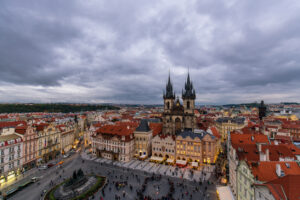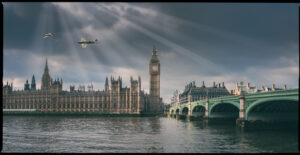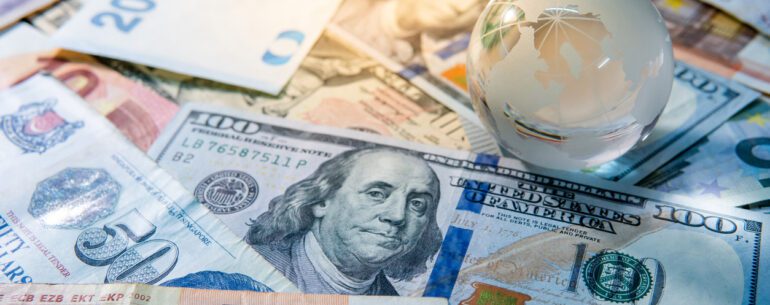In the last pod, I discussed the origins of heroin. Here I’ll go further to talk about the drugs that fueled Nazi Germany.
I’ve long been a student of World War II, but there’s so much more to know. Most of what’s here I learned from a book titled Blitzed by Norman Ohler. He expounds on how stimulants fueled Nazi aggression.
After World War I, the British and French started acquiring natural stimulants like coffee, tea, vanilla, etc., from their various overseas colonies. But “uppers” in Germany had to be produced synthetically because they’d lost most of their colonial possessions under the Versailles Treaty [signed after the war].
Germans were beat-down after losing WWI—its population suffered both physically and mentally. So many people sought an escape from hard times thru intoxicants.
Fifty years before the Ramones, they wanted to be sedated. The reason was nobody wanted to think about their responsibility for the death & destruction caused by the war.
Instead, they wanted to flee into imaginary worlds, which set the stage for a booming pharmaceutical industry.
Many of the molecules illegally ingested today were developed over a short time in 1920s Germany.
Back when the beautiful Rhine Valley became known as “Chemical Valley,” Germany fast-cornered the cocaine and opium markets worldwide. The nascent Weimar Republic would soon become the world’s leading distributor of cocaine and heroin.

The same way Americans believe “Made in America” connotes a certain quality, “Made in Germany” labels meant the same to Germans—especially when applied to drugs and medicine.
In the Fall of 1923, Germany’s currency collapsed. 1 US dollar was suddenly worth 4.2 billion marks. And the country’s morality collapsed along with it.
Hedonism filled the vacuum left by the devastation of world war. And due to economic collapse, illicit pleasures got real cheap. Soon Berlin was the place to go for Westerners seeking sex & drugs.
Berlin became the epicenter of debauchery. As Klaus Mann said at the time, “Berlin nightlife, oh boy, oh boy, the world has never seen the like! We used to have a great army, now we’ve got great perversities!”
Drugs were everywhere, and easily accessible. Just about anyone who could afford cocaine was bumpin’ booger sugar.
Even 40% of Berlin doctors were said to be morphine addicts.
The Nazi Ideal
Here’s where it gets interesting. Communists and Nazis hated the “degenerate poison” ravaging the streets. The government wanted to end “pleasure culture” and stigmatized its excesses as “decadently Western.”
The Nazis promised healing through idealogical salvation, symbolized by the swastika. They despised drugs because they wanted Nazism to be the drug of choice.
Hitler promoted himself as the model for a what a healthy Nazi should be—someone who’d forgone worldly pleasures and put his own needs secondary.
This Hitler mythology of self-denial and self-sacrifice was promoted by the media. They’d say he didn’t drink, only ate vegetables, and had no time for women. The propaganda was meant to make Germans believe Hitler was married to the The Reich the same way the Pope is married to the Church.
Allegedly, he wouldn’t even allow himself a cup of coffee. And had thrown his last pack of cigarettes into the Danube River after WWI.
Then when the National Socialists took power on January, 30, 1930, they stifled artificial pleasure-seeking, saying that if you took drugs to experience “unrealities” (aside from those promulgated by National Socialists)—you’d be punished by up to two years in jail. Doctors caught using drugs would get up to 5 years in prison.
There were no HIPPA laws to help Germans maintain medical confidentiality. If a “drug report” came in, experts would examine the patient in question, then order compulsory withdrawal.
Addicts were forced to deal with the horrors of withdrawal by quitting cold turkey. Then when concentration camps were constructed, drug users were sent there alongside modern-day Peter Navarros, Steve Bannons & J6’ers. That is to say, political prisoners.
Of course it wasn’t just political prisoners sent to work camps. Jews, Communists, Socialists, trade unionists, Roma (Gypsies), Jehovah’s Witnesses and gays, were also sent away. Not to mention Poles, Soviets and Frenchmen.
The Nazi “War on Drugs” was used as an excuse to go after marginalized groups and minorities. Those deemed “criminally insane,” which included drug users, were murdered in the first years of World War II.
For purposes of racial hygiene, they didn’t want severe addicts to reproduce.
Since this is Election Day, might be a good time to point out that if you think Trump and his supporters are Nazis, you’re ignorant of history. And there are plenty blogs for the brainless you can click to.
Hitler’s Personal Physician
In 1933, Dr. Theodore Morell was accused of being a Jew due to his dark complexion. So he quickly joined the Nazi party in an effort to avoid further hostilities.
Dr. Morell specialized in injections. If vitamins & supplements didn’t help the patient feel better, he would add a stimulant to the mix.
In 1936, the doctor received an important phone call from Nazi Headquarters in Munich. The official Reich photographer, who was Eva Braun’s (Hitler’s lover) former boss, was sick and needed help.
So the Führer summoned Dr. Morell, sending a plane to Berlin to retrieve him. Turns out, the cameraman had contracted gonorrhea. He was making it clap before Busta Rhymes was born.
Hitler was impressed with how quickly the photographer healed, and shared with the doctor that he’d been experiencing stomach and intestinal pain for years.
Morrell said he could help. So Hitler invited him that night to his mountain retreat near Berchtesgaden (one of my favorite places to visit in the world).

Hitler told Morrell that if he could in fact cure him, he’d be given an elegant villa on Berlin’s Schwanenwerder Island.
The injections worked. And Hitler decided to appoint himself a new personal physician; Dr. Morell got new digs. His new next-door neighbor on the exclusive island was named Joseph Goebbels.
Hitler liked that Morell didn’t pry into root causes of his illnesses—opting instead to stick a needle in his vein for immediate relief. From then on Hitler would receive several injections a day.
Hitler Invades Prague
While the Nazis’ “war on drugs” was successful against cocaine and heroin, a prominent pharmacist named Dr. Fritz Hauschild learned many athletes had successfully used a stimulant called Benzedrine (legal at that time) at the 1936 Olympic Games in Berlin.
So in 1937, pharmaceutical giant Temmler, started synthesizing methamphetamine. It was found to be similar to adrenalin, but didn’t cause the same rise in blood pressure and lasted longer.
The drug set the user’s neuronal networks ablaze. They suddenly felt wide awake, energetic, more confident, a sense of euphoria, and an overall sense of lightness and freshness. Meth’s effects could be felt for 12 hours.
Excitedly, Temmler began a PR blitz for their new concoction. They put up advertisements on trams, buses and in subways. They would call the new drug, Pervitin.
The goal of Pervitin was to “reawaken joy in the despondent—one of the most valuable gifts that this new medication can give to patients.” The patient leaflet said it would increase women’s libido and compensate for awful withdrawal from alcohol, cocaine and opiates.
Pervitin was like the 1930s Adderall. Students used it to study, nurses to make it through the night shift, and just about anybody working mentally or physically demanding jobs.
Around this time (1930s), Germany’s economy came roaring back. And its military was as strong as ever. But losing the First World War made Germany realize they had too few natural resources. So plans for expanding the Nazi state were drawn up.
The Rhineland was remilitarized and Austria was annexed. Czechoslovakia was next to be defeated [for which Dr. Morell played a prominent role].
In 1939, Czech president Emil Hácha, after refusing to sign a document to surrender his troops to the Wehrmacht, suffered a heart attack. When Hitler heard this news, he sent Morell to inject him with a stimulant that brought him back to good health. Hácha then signed on the dotted line, sealing the fate of the Czechs.
The next morning Hitler invaded Prague without a fight.

The Third Reich came to believe their biggest adversary wasn’t other countries, but fatigue. So Otto Ranke, Head of the Research Institute of Defense Physiology, declared “war on exhaustion.”
Ranke said, “Relaxing on the day of fighting can decide the battle…Often in combat perseverance in that last quarter of an hour is essential.”
Drugs and World War
On September 1, 1939, the Nazis were hopped up on methamphetamine when they attacked Poland.
A report from the German front lines stated: “Often there is euphoria, an increase in attention span, clear intensification of performance, work is achieved without difficulty, a pronounced alertness effect and feeling of freshness. Worked through the day, lifting of depression, returned to normal mood. The feeling of hunger subsides. One particularly beneficial aspect is the appearance of a vigorous urge to work. The effect is so clear that it cannot be based on imagination.”
Absent fatigue or inhibitions, thanks to Pervitin, Nazi forces killed 100,000 Polish troops, along with 60,000 civilians.
On September 3, 1939, Britain and France declared war on Germany, which surprised Hitler—he mistakenly believed the West would react the same way to the defeat of Poland as they did to Czechoslovakia.
Instead, the Nazi invasion of Poland marked the start of World War II.
Pervitin for the…Loss!
“Pervitin seems ideally suited as a stimulant for counteracting signs of fatigue after great physical and mental efforts, particularly among brain-workers and soldiers…who have special demands made on their mental freshness and their capacity for absorption and concentration as well as their judgment, and who must reduce their need for sleep. Some of the observations…were carried out during the Polish campaign.” – Nazi General
Nazi success in Poland had the Nazi Head of Defense Physiology demanding Temmler increase production of Pervitin.
“The experience in the Polish campaign has shown that in certain situations military success was crucially influenced by overcoming fatigue in a troop which strong demands had been made…the stimulants are available for the interruption of sleep. Pervitin has been methodically included in medical equipment.”
Nazis believed their success lied in speed and surprise. Thus, the Wehrmacht became the first army in the history of the world to rely on a chemical substance to win a war.
Fueled by the use of Pervitin, Germany invented the concept of blitzkrieg—which enabled them to conquer more territory in less than a hundred hours than they had in 4+ years fighting World War I.
France fell in eleven days. And Nazi troops occupied Paris almost as easily as they did Prague.
As Elon Musk said on Joe Rogan Experience yesterday, “People give France a hard time about capitulating in World War II. But you know what’s worse than the Nazis? Nazis on meth!”
London would be different. The Battle of Britain began in late 1940, when London was attacked by bombers. Hitler’s goal was to decapitate Britain from the air. They first bombed Air Force targets such as aerodromes, hangars, landing strips and planes.
But Britain responded by bombing the Berlin districts of Kreuzberg and Wedding in a night raid on August 25, 1940. So Hitler ordered an attack on London to demoralize its population and over 40,000 civilians were killed.

A bomber pilot for the Luftwaffe said at the time, “The launch was very often late, ten o’clock, eleven o’clock, and then you were over London or some other English city at about one or two in the morning, and of course you’re tired. So you took one of two Pervitin tablets, and then you were all right again…I took Pervitin as a precautionary measure. Imagine the commander being tired in battle! Uh, yes, please, that’s not going to work…One wouldn’t abstain from Pervitin because of a little health scare. Who cares when you’re doomed to come down at any moment anyway.”
Eventually, the Allieds realized Germany’s relentless pursuit of its aims was aided chemically rather than ideologically. Plus, the Royal Air Force was more determined and better organized than the Reich. Germany suffered its first defeat of World War II.
In the latter half of 1944, Germany lost on all fronts of the war. The Allieds liberated Paris in August, and the Wehrmacht was forced to retreat from all across southern Europe.
On September 11, American troops reached the German border. Pervitin by this time was being used primarily to flee the enemy.
To be continued…
Further reading:
- Blitzed by Normal Ohler
- The Rise and Fall of the Third Reich by William Shiner




Leave a Reply